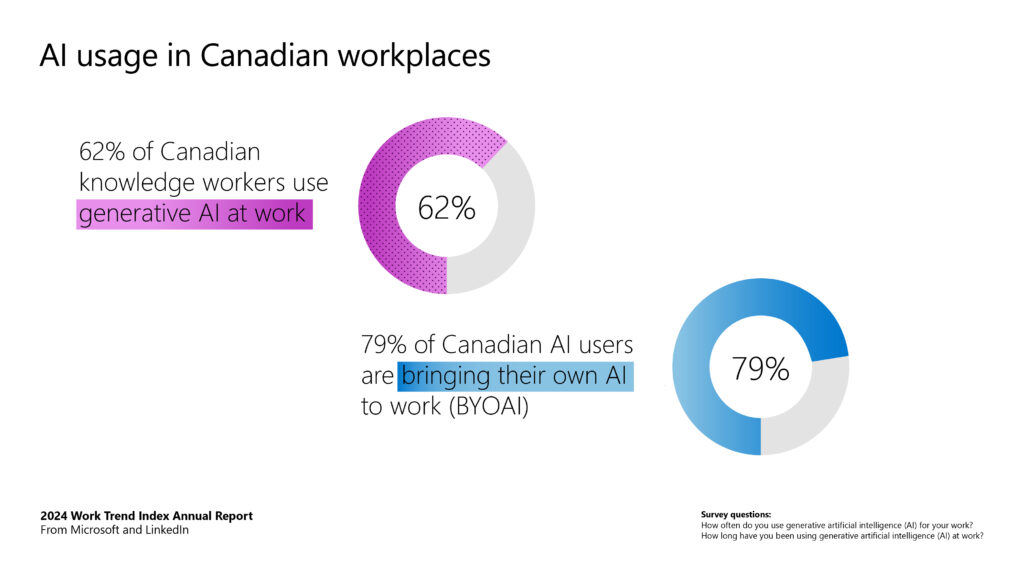Artificial Intelligence (AI) is transforming Canadian government operations, balancing innovation with the need for responsible and secure implementation. Cate Takemori, Public Sector Lead at Microsoft Canada, discusses how to navigate this evolving landscape.
The use of generative AI (Gen AI) in the workplace is not just a future possibility—it’s a present reality. According to the latest Work Trend Index, a new report from Microsoft and LinkedIn, 62% of Canadian knowledge workers are already using AI at work. This widespread adoption is driven by the benefits AI offers in terms of time saving, increased productivity, and the reduction of mundane tasks—an enticing prospect for government employees who are often bogged down by routine, administrative work.

Navigating the intricacies of government operations can be challenging, even for government employees themselves. It’s no surprise that Canadian public sector workers are eager for tools to streamline processes and free them from routine tasks. With more time saved, staff can focus on mission priorities and tackling complex problems. They may also be able to reduce burnout, increase efficiency between departments and minimize administrative burdens. What’s perhaps even more exciting is the possibilities for Gen AI to create better resident experiences, making interactions with government more accessible and less time-consuming.
Despite all these benefits (and the fact that 74% of Canadian leaders acknowledge the necessity of AI to maintain a competitive edge), 59% are concerned about their organization’s lack of a concrete plan for AI implementation. This uncertainty is leading to a growing trend known as Bring Your Own AI (BYOAI), with 79% of Canadian AI users introducing their own AI tools to their workplace.

This groundswell of excitement and increased use of AI is encouraging. However, the emerging BYOAI trend highlights a critical issue: data and security. Government employees experimenting with their own tools could put data at risk. Governments maintain vast amounts of sensitive data, including personal information of residents like property tax details and infrastructure data such as traffic cameras and water systems. This makes the need for robust and responsible AI adoption plans at all levels of government even more urgent.
Creating a Culture of Innovation
While complexity is inherent in strong AI development, the latest research shows that employees are eager for change and clear guidance.
One of the first things to consider when rolling out generative AI tools at any level of government is creating a culture of innovation. To do this, it is important to address and remove any fear or stigma associated with technology like Gen AI. Nearly half *(47%) of people interviewed in the Work Trend Index said they were reluctant to admit to using AI for some of their most important work tasks for fear they may be perceived as replaceable. At best, this stifles innovation. At worst, it means employees are using their own AI tools in secret, putting security at risk.
To solve this challenge, it is important that leaders focus on building their own AI skills and provide similar training opportunities for staff. Being clear about the benefits with staff as well as their role in the process is critical to ensuring people feel safe to experiment and bring new ideas to the table. In Canadian companies that have access to training, especially on prompt writing and how to use AI for their specific role or function, so-called “AI power users” quickly emerge. These power users are 124% more likely to experiment with different ways of using AI. This is because they understand how and feel supported to do so, without any stigma or fear. The result is that they are spending more time at work making a higher impact, driving innovation and ultimately, creating better services for residents.
Championing AI from the Leadership Level
An excellent way to ensure AI usage is used responsibly is to ensure that leaders within the public sector are regularly talking to employees about the benefit, possibilities and importance of Gen AI. Those that are seeing the most benefit from AI are 65% more likely to have heard their senior leaders talk about it. This also helps remove any stigma by promoting AI literacy, a skill that is increasingly sought after by hiring managers. 63% of Canadian leaders are more likely to hire a less experienced candidate with AI skills than a more experienced one without them. And 50% said they wouldn’t hire someone without AI skills at all. This trend underscores the increasing importance of AI literacy in the modern workforce and signals a shift in how government and other sectors evaluate potential hires.

Communicating a Clear Vision
Finally – and perhaps most importantly – developing and communicating plans for responsible use and deployment is critical. This can be accomplished through robust security measures alongside training opportunities for staff developing or using AI so that they understand legal, ethical and operational issues, including privacy and security.
Public sector organizations should create responsible AI strategies that include principles, practices, tools, and governance to manage AI effectively. This may involve:
- Adopting new policies and guidelines
- Ensuring representative and unbiased data
- Establishing governance bodies to scrutinize sensitive use cases
- Maintaining accountability for AI systems
AI has the potential to transform the public sector. Once potential risks are well understood and carefully managed, the public sector can realize the promise of AI. Forward-looking leaders must ensure that their commitment to responsible AI is not an afterthought but is baked into their organization’s innovation pipeline. This allows the public sector to use AI in a way that improves citizen services and benefits society as a whole.
Success Stories of AI in the Public Sector
Across Canada, forward-thinking governments at all levels are using AI every day to tackle everything from administrative tasks to service delivery. Here are a few examples.
City of Kelowna
The City of Kelowna has embraced AI technology to enhance resident services and streamline municipal processes. Using Gen AI technology, Kelowna has significantly improved the process of applying for building permits by implementing an AI Copilot that automatically fills out official forms based on resident’s input, speeding up the process and reducing administrative work for government staff. Additionally, the city rolled out voice and chat Copilot assistants to address common inquiries, significantly increasing accessibility to information and freeing up government staff for more impactful tasks.

Another area where AI is improving the experience of Kelowna residents is with the city’s annual recreation guide. Previously published as a static PDF, this guide now benefits from an AI Copilot integration, making it more engaging and personalized. Instead of scrolling through a static document, users receive dynamic, tailored recommendations for activities, programs, and events based on their interests, from sports leagues and fitness classes to cultural events and parks.
City of Burlington
The City of Burlington is pioneering AI integration into municipal services with the introduction of CoBy, its first AI-powered digital assistant available on the city’s website, burlington.ca. This new Copilot provides 24/7 access to a wealth of city information and services, offering real-time AI-generated responses based on extensive knowledge gathered from the website. Developed in collaboration with Microsoft Copilot Studio, CoBy has been designed to learn over time, constantly evolving, adapting, and improving from each interaction. Users can simply click on the green conversation bubble icon on the website to pose questions, and CoBy utilizes Generative Pre-trained Transformer (GPT) technology to provide efficient responses. Currently in the beta phase, CoBy will continue to develop over time, influenced by user feedback and patterns learned through generative AI.
Metrolinx
Metrolinx, Ontario’s transportation agency responsible for PRESTO, which serves the Greater Toronto and Hamilton Area (GTHA) and Ottawa, is using Azure AI to modernize fare payment systems. Building on the success of the PRESTO fare card, Metrolinx launched a project for open payments, which would enable riders to conveniently tap on and off transit using their credit or debit cards. With Microsoft Azure, the agency has implemented a real-time fare management system, ensuring seamless transactions even during peak travel times. Overcoming challenges like the need for quick processing, Metrolinx rolled out the payment platform across regional transit networks, including TTC, GO Transit, MiWay, and UP Express. With an emphasis on security, Metrolinx uses Microsoft’s robust security infrastructure to safeguard sensitive data, allowing them to focus on providing a secure and efficient experience for all transit users.

Looking Ahead: A Bright Future for Canada
While governments have historically moved slowly—especially as it relates to technology—generative AI presents an opportunity to accelerate the pace of change. AI doesn’t always have to involve broad sweeping change either. It could be as simple as leveraging AI to take over administrative work, as in the case of the cities of Kelowna and Burlington. This, in turn, frees up employees to focus on bigger mission challenges. But there is still much work to be done to implement AI solutions at scale, to develop a workforce with the skills necessary to do so, and to take advantage of all that AI has to offer.
By engaging with employees and creating clear plans and policies for responsible AI use, governments can unlock significant potential for innovation, improved processes, and streamlined operations—key priorities for any government agenda.
*Based on global findings from the Work Trend Index. Canadian specific data not available.

